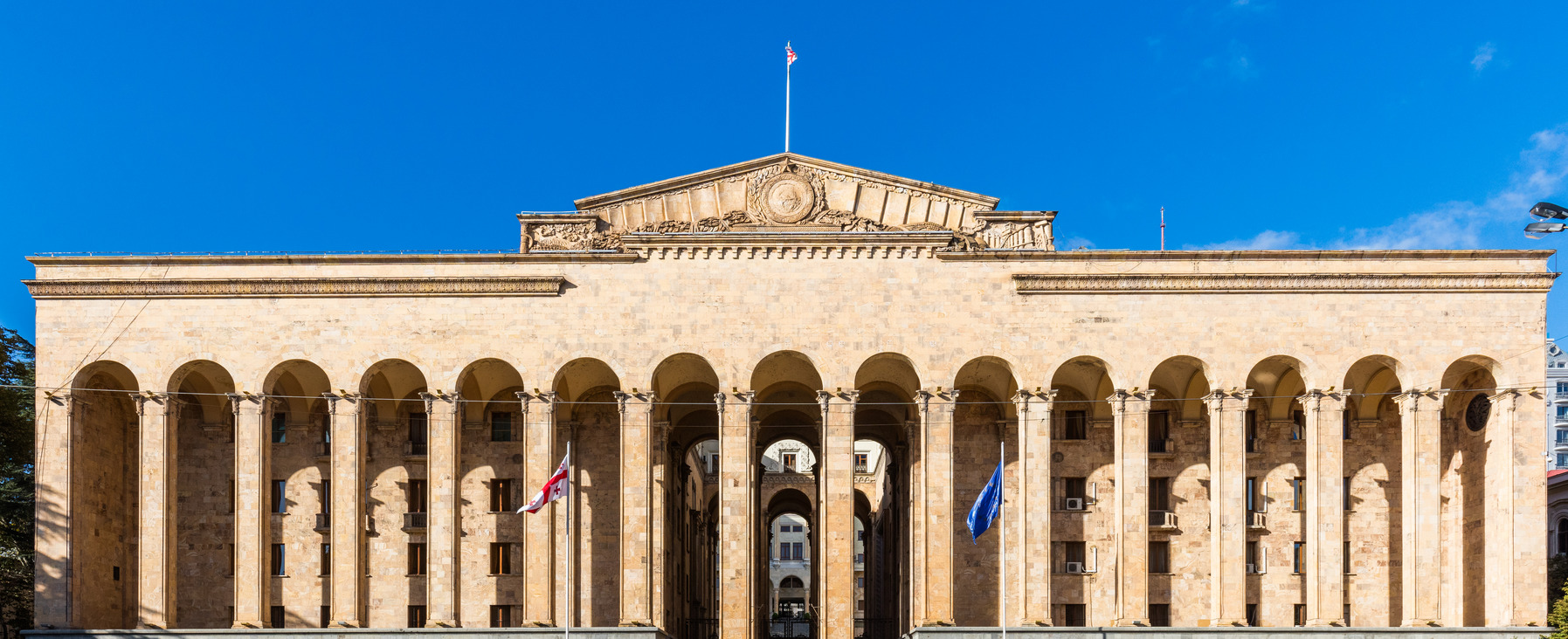
Georgia’s Parliament building is faced in golden tuff, a material intrinsic to national architecture, which also displays the characteristic of this volcanic rock through its decorative application. As you walk down Rustaveli Avenue, you will see it used elsewhere, most notably on the National Academy of Sciences of Georgia, a little further along the street. It elevates these buildings through its beauty, and I thought it deserved an EarthCache to highlight this local geological feature.

Tuff is a type of igneous rock. Igneous rocks are formed through the cooling and solidification of volcanic material – usually lava or magma. In the case of tuff, it is formed from deposits of volcanic ash which is lithified – or compacted under pressure – to form a solid rock. Tuff can sometimes be described using terms applied to sedimentary rocks, as it often forms in layers due to successive eruptions. To be defined as tuff, the composition of the rock should be at least 75% volcanic material.
The age, mineral composition and appearance of tuff can vary enormously. Volcanic eruptions have occurred throughout Earth’s history in widespread locations, each with its own unique geological features. These factors can significantly affect the colour and texture of the tuff.
Another variable is the very different particle sizes which can form tuff. Nearer to the vent, or eruption site, tuff may be formed of large lumps of volcanic lava which cool before they hit the ground, held together with a volcanic ash matrix, giving the appearance of a conglomerate. Alternatively, tuff can be formed by layers of very fine volcanic ash, carried away from the vent on the wind, which settles in layers.
Tuff is one of the many rocks found extensively in mineral-rich deposits of Georgia’s mountains. It is mined locally in Bolnisi, to the south of Tbilisi. Tuff is a relatively soft rock, which makes it useful in construction as it can easily be cut and shaped, as demonstrated by its application here.
Please note, you may not be able to access the rock directly, but should be able to make your observations from the pavement outside the building.
TASKS:
Describe the appearance of the tuff used to face Georgia’s Parliament Building, including its colour, texture and any notable features
Having read how tuff is formed, do you think the tuff used here was formed near to the volcano’s eruption site or further away? Why?
Describe how the features of this tuff have been highlighted by its application to the building
Please take a photo of yourself, or your geocaching name and the date of your visit, outside the building and upload it with your log.
 [Google translate]
[Google translate]
საქართველოს პარლამენტის შენობა მოპირკეთებულია ოქროს ტუფით, ეროვნული არქიტექტურისთვის დამახასიათებელი მასალა, რომელიც ასევე გამოხატავს ამ ვულკანური კლდის მახასიათებლებს მისი დეკორატიული გამოყენების გზით. რუსთაველის გამზირზე რომ მიდიხართ, დაინახავთ, რომ ის გამოიყენება სხვაგან, განსაკუთრებით საქართველოს მეცნიერებათა ეროვნულ აკადემიაში, ცოტა უფრო შორს ქუჩის გასწვრივ. იგი ამაღლებს ამ შენობებს თავისი სილამაზით და ვფიქრობდი, რომ იმსახურებდა დედამიწის ქეში ამ ადგილობრივი გეოლოგიური მახასიათებლის ხაზგასასმელად.

ტუფი არის ცეცხლოვანი ქანების სახეობა. ცეცხლოვანი ქანები წარმოიქმნება ვულკანური მასალის გაგრილებისა და გამაგრების შედეგად - ჩვეულებრივ, ლავას ან მაგმას. ტუფის შემთხვევაში, იგი წარმოიქმნება ვულკანური ფერფლის საბადოებიდან, რომელიც ლიტიფიცირებულია - ან დატკეპნილი ზეწოლის ქვეშ - მყარი კლდის წარმოქმნით. ტუფი ზოგჯერ შეიძლება აღწერილი იყოს დანალექი ქანების მიმართ გამოყენებული ტერმინების გამოყენებით, რადგან ის ხშირად წარმოიქმნება ფენებად თანმიმდევრული ამოფრქვევის გამო. ტუფად რომ განისაზღვროს, კლდის შემადგენლობა უნდა შედგებოდეს სულ მცირე 75% ვულკანური მასალისგან.
ტუფის ასაკი, მინერალური შემადგენლობა და გარეგნობა შეიძლება ძალიან განსხვავდებოდეს. ვულკანური ამოფრქვევები დედამიწის ისტორიის განმავლობაში მოხდა ფართოდ გავრცელებულ ადგილებში, თითოეულს თავისი უნიკალური გეოლოგიური მახასიათებლებით. ამ ფაქტორებმა შეიძლება მნიშვნელოვნად იმოქმედოს ტუფის ფერსა და ტექსტურაზე.
კიდევ ერთი ცვლადი არის ნაწილაკების ძალიან განსხვავებული ზომები, რომლებსაც შეუძლიათ შექმნან ტუფი. ვენტილაციასთან ან ამოფრქვევის ადგილთან უფრო ახლოს, ტუფი შეიძლება წარმოიქმნას ვულკანური ლავის დიდი სიმსივნისგან, რომელიც გრილი სანამ მიწაზე მოხვდება, ვულკანური ფერფლის მატრიცასთან ერთად ინახება, რაც კონგლომერატის იერს აძლევს. ალტერნატიულად, ტუფი შეიძლება წარმოიქმნას ძალიან წვრილი ვულკანური ფერფლის ფენებით, რომელიც მოშორებულია ქარის სავენტილაციოდან, რომელიც ფენად დევს.
ტუფი ერთ-ერთია იმ მრავალ ქათაგან, რომელიც ფართოდ გვხვდება საქართველოს მთების მინერალებით მდიდარ საბადოებში. ადგილობრივად მოიპოვება ბოლნისში, თბილისის სამხრეთით. ტუფი შედარებით რბილი კლდეა, რაც მას კონსტრუქციაში გამოსადეგს ხდის, რადგან მისი ადვილად მოჭრა და ფორმირება შესაძლებელია, რაც ადასტურებს მის გამოყენებას აქ.
გთხოვთ გაითვალისწინოთ, რომ თქვენ შეიძლება ვერ შეხვიდეთ კლდეზე პირდაპირ, მაგრამ უნდა შეძლოთ თქვენი დაკვირვების გაკეთება შენობის გარეთ ტროტუარიდან.
ᲓᲐᲕᲐᲚᲔᲑᲔᲑᲘ:
აღწერეთ ტუფის გარეგნობა, რომელიც გამოიყენება საქართველოს პარლამენტის შენობის წინ, მისი ფერის, ტექსტურის და ყველა მნიშვნელოვანი მახასიათებლის ჩათვლით
წაკითხვის შემდეგ როგორ წარმოიქმნება ტუფი, როგორ ფიქრობთ, აქ გამოყენებული ტუფი წარმოიქმნა ვულკანის ამოფრქვევის ადგილთან ახლოს თუ უფრო შორს? რატომ?
აღწერეთ, როგორ გამოიკვეთა ამ ტუფის თვისებები შენობაში მისი გამოყენებისას
გთხოვთ გადაიღოთ საკუთარი თავი, ან თქვენი გეოშინგის სახელი და ვიზიტის თარიღი, შენობის გარეთ და ატვირთოთ იგი თქვენს ჟურნალთან ერთად.